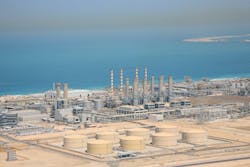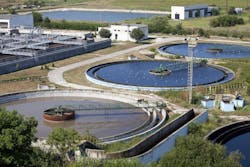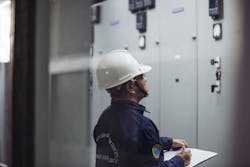Automation for the Global Water Crisis
We are facing the greatest water crisis in the history of humankind. Although almost three-quarters of the earth is made up of water, only 2.5% is fresh water. Each year, humans use 10 billion tons of freshwater globally for agriculture, industry, and household use, including drinking water.
By 2030, the UN predicts human demand for water will be 40% higher than the available supply; however in the U.S., consumption of water already outweighs supply. Water scarcity is an increasing issue in drought struck areas with 40 out of 50 states expecting water shortages. On average, each American uses 80 to 100 gallons of water every day, with the nation’s estimated total daily usage topping 345 billion gallons.
Across the rest of the world there are similar patterns emerging. The UK, for example, was warned recently by its Environment Agency that London and the southeast of England could run out of water within 25 years. The cost of a severe drought to London’s economy is estimated to be £330 million per day, meaning severe economic, social, and environmental consequences.
Leakages & Losses
A water main break occurs every two minutes in America, wasting approximately 6 billion gallons of treated water each day, according to the American Society of Civil Engineers. Within as little as 50 years, many regions of the United States could see their water supply reduced by as much as a third.
In developing countries, according to the World Bank, roughly 45 million cubic meters of water is lost daily, costing a staggering $3 billion USD per year.
Currently enormous volumes of wastewater are pumped into rivers, oceans and streams. The effect on the environment, fisheries, animals and public health if it is not properly treated can be extremely negative. Not to mention it is a ‘waste’ of water too.
The more reclaimed water we can direct towards agricultural and landscape irrigation, industrial processes and non-potable urban applications (such as toilet flushing, street washing, and fire protection) means the less freshwater we are using for these purposes.
Automation systems have helped utilities optimize process and subsequently the performances of their wastewater plants. In the U.S., Baltimore and Nashville are working toward making the most of their wastewater, reducing costs and optimizing the amount of wastewater that can be treated.
Moreover, new smart solutions for wastewater are available that are scalable and modular. They blend expert knowledge in advanced process control, digital twin, process simulation, and performance optimization. These solutions increase operational control and efficiency while lowering plant energy use and running costs of operations.
These technologies can help utilities achieve up to 25% savings in process related energy expenditure (specifically related to Bioreactors aeration) and up to 10% reduction of chemicals needed in the process.
Managing Water Around the World
Smart water management, serving the entire water cycle, from sourcing and treatment to distribution and discharge, is key to providing reliable access to safe, clean water
Water demand is increasing but supplies are not. Driven by population growth and the rising demand in industrial and domestic sectors, ensuring everyone has access to safe and reliable water supply is a critical challenge.
Throughout the world we must achieve more with fewer resources. This requires innovation to develop new methodologies that reduce the risk of water shortages by increasing resilience, optimizing water production while reducing energy consumption, as well as minimizing the threats posed by flooding, contamination, and poisoning. For example, ABB is working with partners and customers to deploy solutions that help achieve these goals.
In India, 54% of the country faces high to extremely high-water stress, affecting nearly 1 million people each year. In addition to affecting the huge rural and urban population, the water scarcity in India also extensively affects the ecosystem and agriculture with country only accessing 4% of the world’s freshwater resources despite a population of over 1.3 billion people.
ABB has been working to deploy its solutions in the Koppal district, which with a population of around 1 million people. The region is regularly challenged by water shortages. In this project, the team is helping the local water authority to track, measure and optimize water use, as well as pump and distribute clean treated river water to village homes.
Delivering an end-to-end solution that includes 635 digital flowmeters, the project will put in place a network of remote terminal units for remote locations and pumping stations to supervise and control operations. Monitoring and analyzing daily flow consumption patterns, the local water authority can identify possible leaks and send the information in real-time to the central control room, helping avert water losses and identifying leaks swiftly.
In Surat (India), ABB is helping the Surat Municipal Corporation (SMC), the governing civic authority, to study water consumption patterns, reduce water waste and automatically track water use throughout the city. At the heart of the textile industry, where nearly 30 million meters of raw fabric are processed every day, Surat’s industry consumes huge quantities of water. To put it into context, it is estimated that the global textile industry alone uses over 400 million gallons of water every day.
To support SMV’s needs ABB installed 240 digitally enabled flowmeters in the inlet pipes of municipal water lines enabling automatic meter readings (AMR) that measure water flow and send precise readings to the corporation’s control center. Moving away from manual flowmeters to digital enabled solutions ensures the data collected from readings will be accurate and delivered in real time providing operators live analysis on the consumption patterns.
Reclaiming Water
Another key action in combating water shortages is desalination, a technology process to produce fresh water from the sea. However, the cost of desalination can be high with energy efficiency and life-cycle cost optimization among the most important challenges for utilities in this space.
Solutions such as the ABB Ability™ System 800xA distributed control system are available to address these matters head-on. This, combined with digital solutions, optimizes the production process by identifying optimal operational points, giving operators insights to make immediate operational decisions (e.g., taking equipment into service or out of service to provide the same production levels, but with less energy).
With insights from ‘big data’ delivered in real-time, operators can make informed decisions to drive efficiencies that enable operational excellence, ensure asset reliability and availability, mitigate risk and ultimately enhance performance and productivity.
In Singapore, this control system has optimized production and increased process efficiency at The Keppel Marina East Desalination Plant (KMEDP). The plant is one of the most advanced desalination plants in the world and the first in the world with a dual-mode facility.
Producing more than 30 million gallons of clean water every day — enough to fill 45 Olympic-size swimming pools — the plant can supply around 7% of Singapore’s daily water demand, drawing water from the surrounding sea during periods of dry weather or treating water from the Marina Reservoir during periods of heavy rain
The wastewater treatment industry also plays a critical role addressing the water challenge. Converting wastewater through treatment, from its unusable state so that it can be returned to the water cycle with minimal environmental issues or reused for another purpose is vital in helping bridge the gap between the growing demand for and scarcity of this precious resource.
Currently enormous volumes of wastewater are pumped into rivers, oceans and streams. The effect on the environment, fisheries, animals and public health — if it is not properly treated — can be extremely negative. Not to mention it is a ‘waste’ of water too.
The more reclaimed water we can direct towards agricultural and landscape irrigation, industrial processes and non-potable urban applications (such as toilet flushing, street washing, and fire protection) means the less freshwater we are using for these purposes.
Transparency & Visibility
Clean water is a fundamental need but bringing this vital resource to people requires a vast amount of work. Data and technology are vital tools for utilities, governments and wider stakeholders as they attempt to navigate the water scarcity challenge, and wider energy transition goals.
In this respect investing in technologies that help operators to identify consumption patterns, monitor flow, forecast demand, manage losses and promote reuse make a world of difference in driving forward the circular water economy and making every drop of water count.



